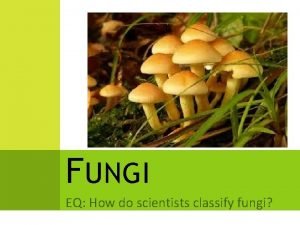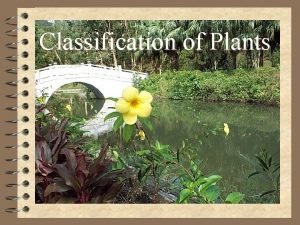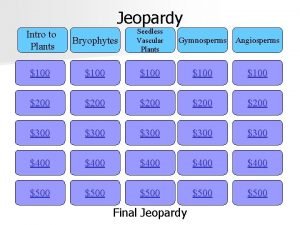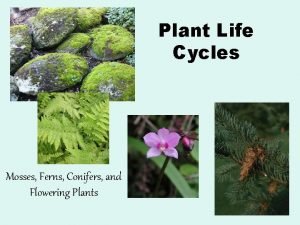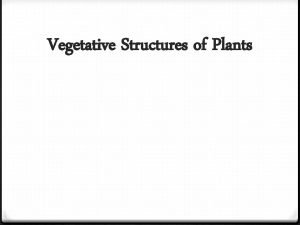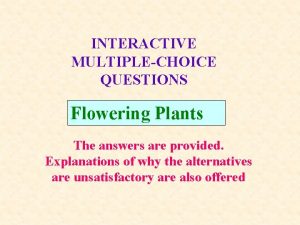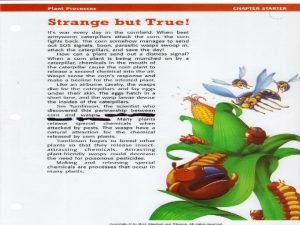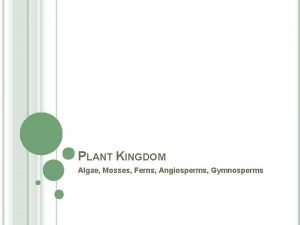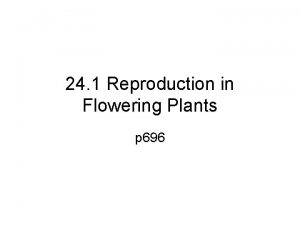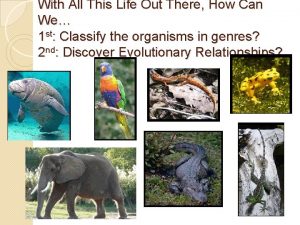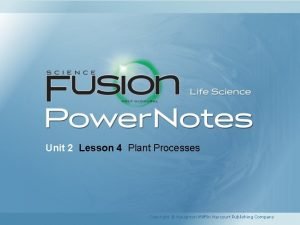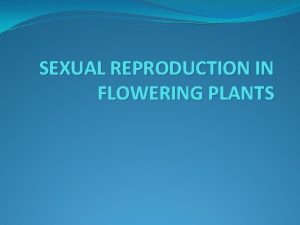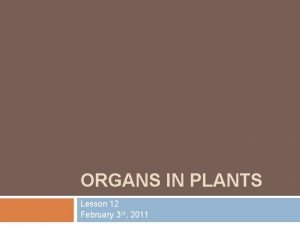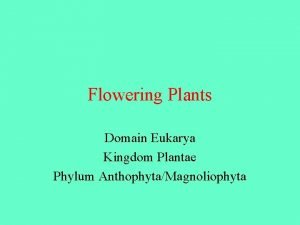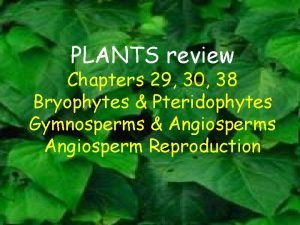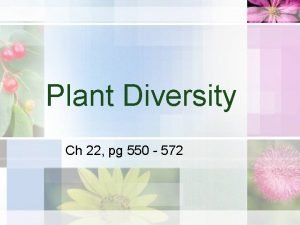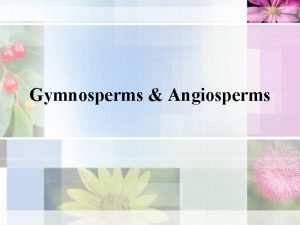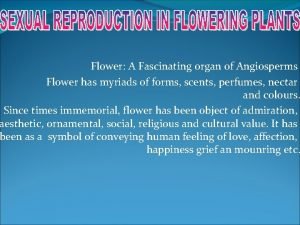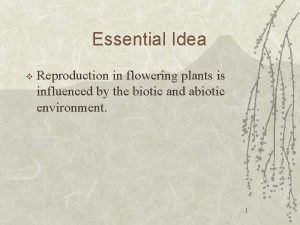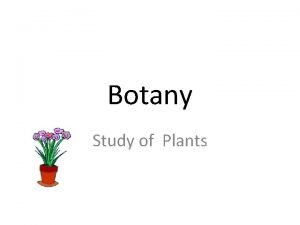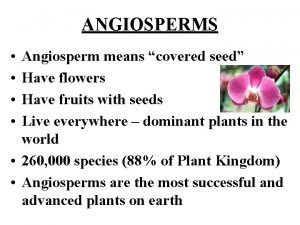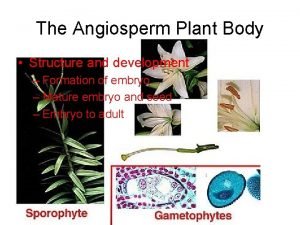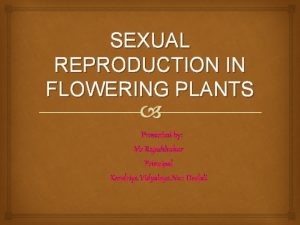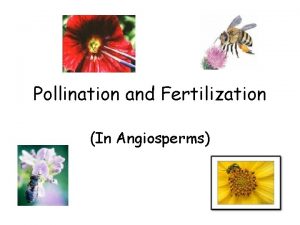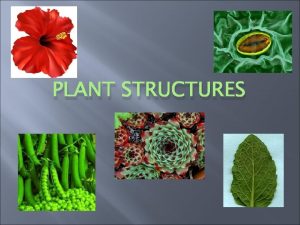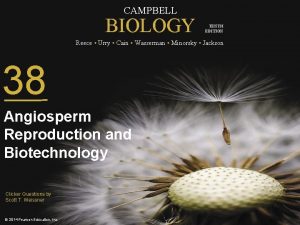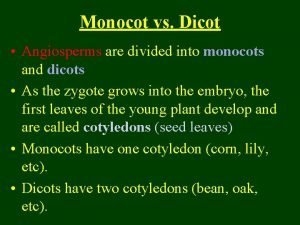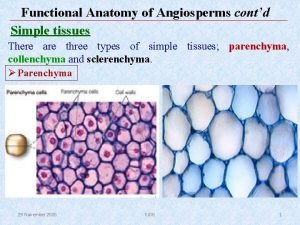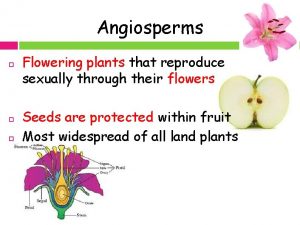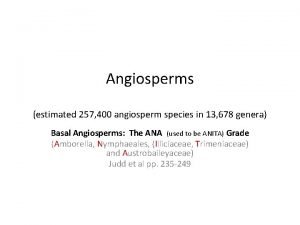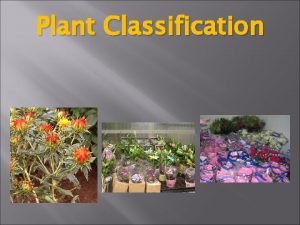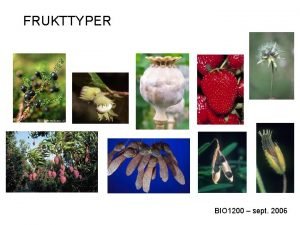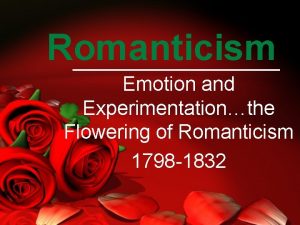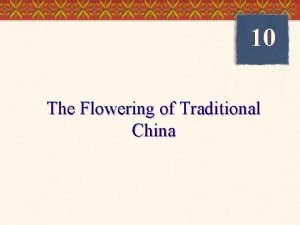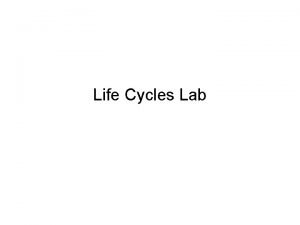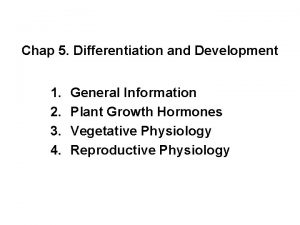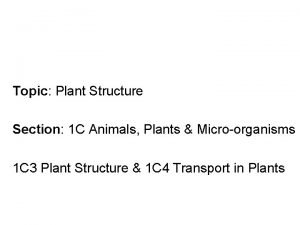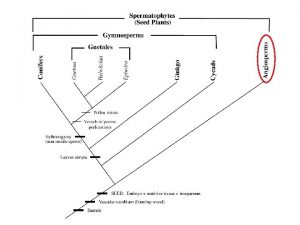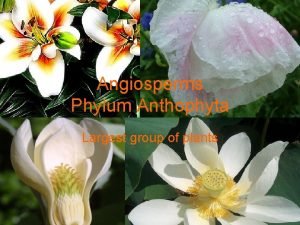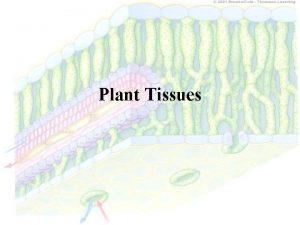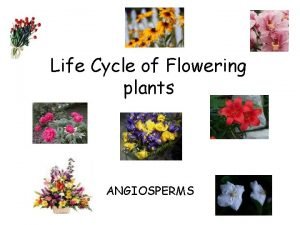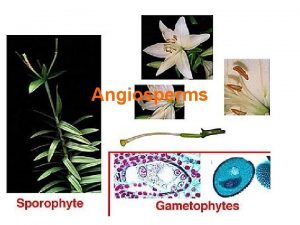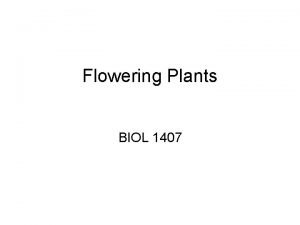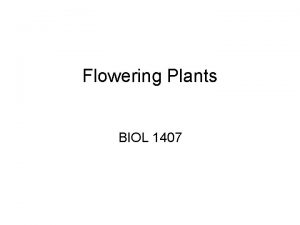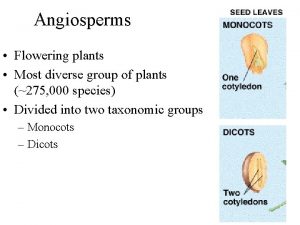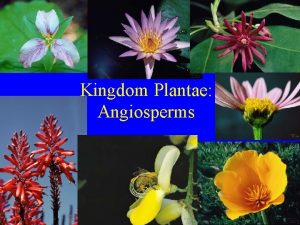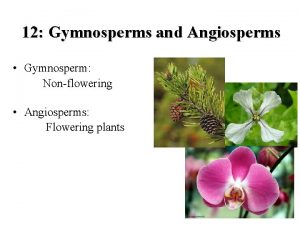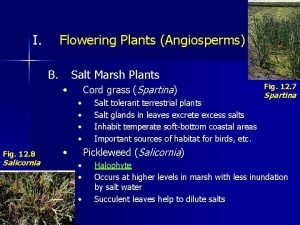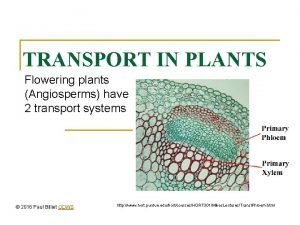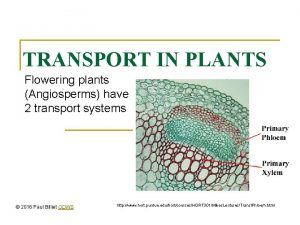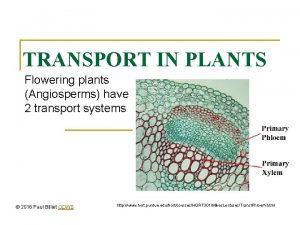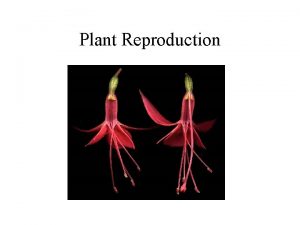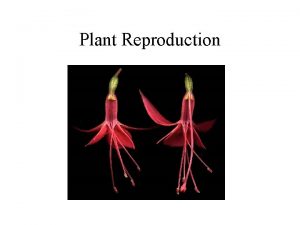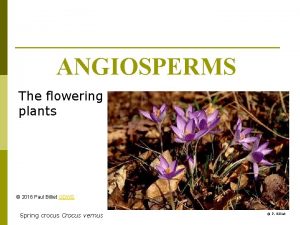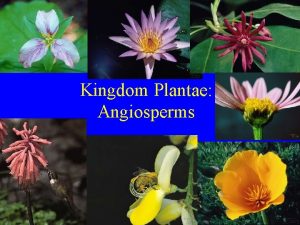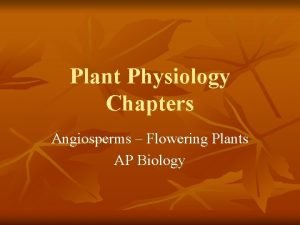Flowering Plants Angiosperms Flowering Plants Angiosperms Largest group













































- Slides: 45


Flowering Plants - Angiosperms

Flowering Plants - Angiosperms • • • Largest group of Land Plants! Most important economically! Apomorphies: 1. 2. 3. 4. 5. Flowers Carpels Fruits Double fertilization with triploid endosperm Specialized conductive cells

Why have Angiosperms been so successful?

1) Flowers What is a flower? = Shoot system bearing modified leaves: } Perianth Calyx (sepals) - green, protective Corolla (petals) - colored, attractant Stamens - male Carpels - female modified leaves

pistil Fig. 30. 7

Flower parts:

Flower pollination (transfer of pollen to ovule): Animal pollination Ancestral for Angiosperms Much more efficient means of transporting pollen All Gymnosperms are wind pollinated (Some Angiosperms secondarily wind pollinated)

Strategy of animal pollination: Attractant Visual: large or brightly colored perianth Olfactory (smell): sweet or rotten (fetid) odor Reward Usually nectar or pollen (Rarely waxes, oils)

Pollination Mechanisms Insects Bees Butterflies/Moths Flies Birds Bats Water Wind

Bee-pollinated

Moth-pollinated

Fly-pollinated

Bird-pollinated

Bat-pollinated

Wind pollination in grasses

Phyllospadix torreyi Surf-Grass Water-pollinated

2) Carpels Carpel = conduplicate megasporophyll Conduplicate = folded Megasporophyll = “female leaf, bearing seeds” Carpel totally encloses ovules/seeds

Carpels can fuse together Gynoecium = all female parts Pistil = ovary + style + stigma Pistil can be one carpel or many

orange: 8 fused carpels carpel

Function of Carpel 1. Protects young seeds 2. Site of pollen germination - Can induce self-incompatibility reactions 3. Fruits

Self-incompatibility - Pollen will not germinate on genetically similar individuals - Promotes outcrossing

3) Fruits Fruit = mature ovary (plus accessory parts) Function: seed dispersal

Fruit types: dry - dispersed mechanically, by wind, water, etc. fleshy - dispersed by animals

4) Double fertilization in Angiosperms Assignment: Study Figs. 38. 2, 38. 3, 38. 5

Double fertilization in Angiosperms Pollen produces 2 sperm cells:

Double fertilization in Angiosperms Pollen produces 2 sperm cells: sperm (n) + egg (n) ----> zygote (2 n) sperm (n) + 2 polar nuclei (n) ----> endosperm (3 n)

Triploid endosperm is nutritive tissue in seeds of Angiosperms. Extra set of genes may help in: 1) rapid development 2) increase genetic variation

Gymnosperms: - Fertilization occurs long after pollination - Seeds mature slowly (1 -2 years) Angiosperms: - Fertilization occurs soon after pollination - Seeds produced rapidly - Selective advantage (e. g. , annual herbs)

5) Specialized conductive cells Most Angiosperms have vessels Specialized in having perforation plates vessel perforation plate

All Angiosperms have sieve tube members -with sieve plates: bigger pores in end walls big callose-lined pores

Angiosperms Vessels and sieve tube members more efficient in water / sugar conduction

Angiosperm Classification

seed coat endosperm Old classification: 2 cotyledons { epicotyl Dicots - 2 cotyledons (seed leaves) embryo hypocotyl radicle NON-MONOCOT Monocots - 1 cotyledon coleoptile epicotyl hypocotyl radicle coleorhiza epicotyl embryo radicle MONOCOTS

Monocots monophyletic

Monocot apomorphies

Monocot apomorphies 1 cotyledon coleoptile epicotyl hypocotyl radicle coleorhiza embryo radicle MONOCOTS 1 cotyledon parallel venation stem an atactostele -many scattered vascular bundles (wood lost!)

Monocots include: Palms Orchids Irises Grasses, etc.

“Dicots” paraphyletic!

Features that defined “Dicots” are primitive (not apomorphies)

Eudicots monophyletic!

Eudicot apomorphy: A A A Pollen tricolpate - 3 apertures

All other Angiosperms: aperture Pollen has 1 aperture

Eudicots include most angiosperms: Roses Legumes Daisies Oaks, etc.

 Examples of non flowering plants
Examples of non flowering plants Flowering and non flowering plants
Flowering and non flowering plants Characteristic of ferns
Characteristic of ferns Angiosperms _____.
Angiosperms _____. Conifer fern
Conifer fern Parts of a root
Parts of a root Multiple choice questions on flowering plants
Multiple choice questions on flowering plants Flower structure and function
Flower structure and function Monstera axillary bud growth
Monstera axillary bud growth What are the 6 main parts of a plant
What are the 6 main parts of a plant Moss fern gymnosperm angiosperm
Moss fern gymnosperm angiosperm Events of fertilization in plants
Events of fertilization in plants Phylogenic
Phylogenic Unit 2 lesson 12 flowering plants
Unit 2 lesson 12 flowering plants Dithecus
Dithecus Plant organ
Plant organ Part of flower that makes pollen
Part of flower that makes pollen Eukarya plantae
Eukarya plantae Plant reproduction
Plant reproduction What is the common ancestor of all plants
What is the common ancestor of all plants Types of angiosperm
Types of angiosperm Polyembyony
Polyembyony Angiosperms double fertilization
Angiosperms double fertilization Contrast gymnosperms and angiosperms
Contrast gymnosperms and angiosperms Angiosperm means
Angiosperm means How do plants reproduce
How do plants reproduce Partes de la semilla
Partes de la semilla Polyembryony
Polyembryony Double fertilization in angiosperms
Double fertilization in angiosperms Partes
Partes Double fertilization in angiosperms
Double fertilization in angiosperms Taproot monocot
Taproot monocot Anatomy of angiosperms
Anatomy of angiosperms Angiosperms
Angiosperms Nymphaeles
Nymphaeles Tagetes lower classifications
Tagetes lower classifications Angiosperms
Angiosperms How does moss reproduce
How does moss reproduce Nonvascular plant diagram
Nonvascular plant diagram Photosynthesis equation
Photosynthesis equation The flowering of romanticism summary
The flowering of romanticism summary The flowering of traditional china
The flowering of traditional china Nitrogen available to plants
Nitrogen available to plants What process occurs
What process occurs Ethylene pineapple flowering
Ethylene pineapple flowering Flowering plant diagram
Flowering plant diagram

